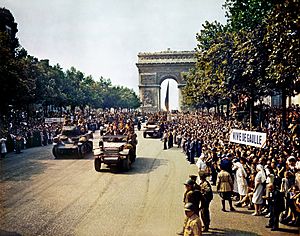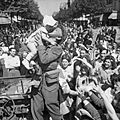Liberation of Paris facts for kids
Quick facts for kids Liberation of Paris |
|||||||
|---|---|---|---|---|---|---|---|
| Part of Operation Overlord of World War II | |||||||
 Parisians line the Champs Élysées for a parade conducted by the French 2nd Armored Division on 26 August 1944 |
|||||||
|
|||||||
| Belligerents | |||||||
• |
|||||||
| Commanders and leaders | |||||||
|
|||||||
| Units involved | |||||||
• • |
|||||||
| Casualties and losses | |||||||
|
|
||||||
The Liberation of Paris (French: Libération de Paris) was a major battle during World War II. It happened from August 19 to August 25, 1944. During this time, the city of Paris was freed from Nazi Germany's control.
Paris had been under German rule since June 22, 1940. This happened after France signed an agreement called the Second Compiègne Armistice. German soldiers, known as the Wehrmacht, then took over northern and western France.
Contents
Paris Under German Control
For over four years, Paris was occupied by German forces. Life was very difficult for the people living there. Food was scarce, and many freedoms were taken away. The German army controlled the city, and people had to follow strict rules.
The French Resistance
Even though Paris was occupied, many French people secretly fought back. These brave individuals were part of the French Resistance. They worked in secret groups to oppose the Germans. They gathered information, sabotaged German plans, and helped Allied soldiers.
The Resistance grew stronger over time. They knew that the Allied forces were getting closer to Paris. They wanted to help free their city.
The Uprising Begins
In August 1944, the Allied armies were advancing across France. The French Resistance in Paris decided it was time to act. On August 19, they started an uprising against the German occupiers.
They built barricades in the streets. These were makeshift walls made of anything they could find. They fought against the German soldiers and police. The Resistance aimed to take control of key buildings in the city.
Fighting in the Streets
The fighting was fierce. Members of the FFI, which was a main part of the Resistance, fought bravely. They used small weapons and their knowledge of the city. The Germans had tanks and more powerful guns.
The Resistance managed to capture some important places. They took over police headquarters and other government buildings. This showed the Germans that the people of Paris wanted their city back.
Allies Arrive
As the uprising continued, the Allied commanders had to make a decision. Should they go straight to Paris or bypass it? General Charles de Gaulle, a leader of the Free French Forces, insisted that Paris must be liberated quickly. He feared the Germans might destroy the city.
On August 24, 1944, the first Allied troops entered Paris. These were soldiers from the French 2nd Armored Division. This division was led by General Philippe Leclerc. Their arrival brought great hope to the people of Paris.
The next day, August 25, more French and American troops arrived. They joined the Resistance fighters in battling the remaining German forces.
Paris is Free!
The German commander in Paris, General Dietrich von Choltitz, realized he could not win. He had been ordered by Adolf Hitler to destroy Paris if he had to retreat. But he refused to do so. He knew it would be a terrible act.
On August 25, 1944, General von Choltitz surrendered Paris to the French and Allied forces. The surrender was signed at the Montparnasse railway station. The city was finally free!
The people of Paris poured into the streets to celebrate. They cheered the Allied soldiers and the Resistance fighters. It was a moment of huge joy and relief. General de Gaulle marched down the Champs-Élysées with his troops.
Why Was it Important?
The Liberation of Paris was a very important event in World War II. It showed that France was fighting back. It also meant that the Provisional Government of the French Republic could be set up in Paris. This government would help rebuild France after the war.
The liberation of Paris was a symbol of hope. It showed that even after years of occupation, freedom could be won. It was a victory for the French people and for the Allied cause.
Images for kids
-
General Omar Bradley, Dwight D. Eisenhower, General Marie-Pierre Kœnig and Air Marshal Arthur Tedder
-
The wall of the 35 martyrs, Bois de Boulogne
-
Three-cent stamp picturing the Arc de Triomphe in Paris, with marching U.S. Army soldiers and an overflight by U.S. Army Air Force.
-
General de Gaulle and his entourage proudly stroll down the Champs Élysées to Notre Dame Cathedral for a Te Deum ceremony following the city's liberation on 25 August 1944.
-
The U.S. 28th Infantry Division on the Champs Élysées in the "Victory Day" parade on 29 August 1944.
-
American soldiers look at the French tricolour flying from the Eiffel Tower.
See also
 In Spanish: Liberación de París para niños
In Spanish: Liberación de París para niños













